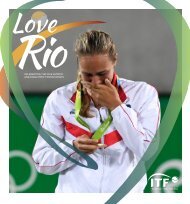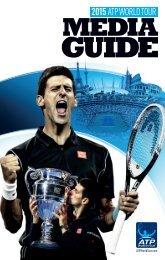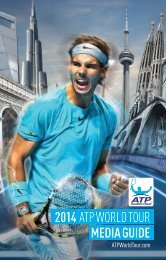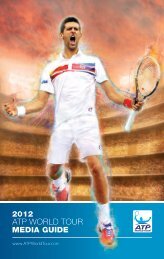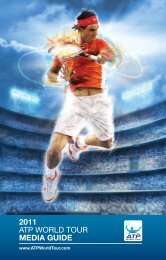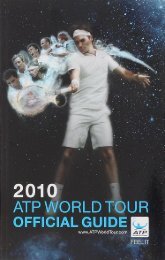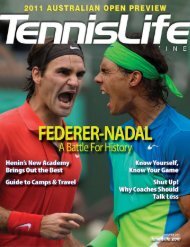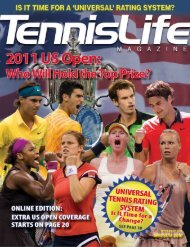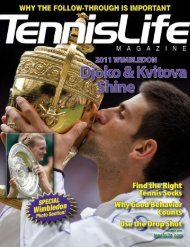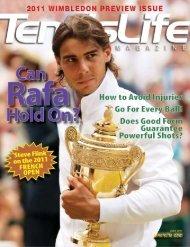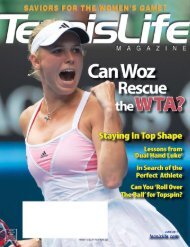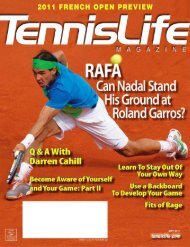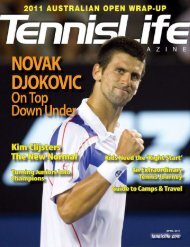A Champion's Mind - Pete Sampras
www.tennismoscow.me Insta:TENNISMOSCOW
www.tennismoscow.me Insta:TENNISMOSCOW
You also want an ePaper? Increase the reach of your titles
YUMPU automatically turns print PDFs into web optimized ePapers that Google loves.
ound-robin was Andre, and he beat me like a drum (6–2, 6–2). Nicolas Lapentti took me to two<br />
tiebreakers in my next match, but I toughed out both of them to stay alive in the round-robin. I notched a<br />
win over Gustavo Kuerten in my final round-robin match, and that qualified me for the knockout<br />
semifinals. After beating Nicolas Kiefer in my first match, I faced Andre—less than a week after he had<br />
tagged me two and two. I surprised him, winning in straight sets.<br />
Despite my win in Hanover, Andre finished 1999 at number one, ending my record run. It was a wellearned<br />
coup. Andre had come back from the dead that year, careerwise, to win the French Open. He also<br />
bagged the U.S. Open while I lay on my sofa in L.A. nursing my sore back. We didn’t really know it, but<br />
we were entering the last and greatest stage of our rivalry.<br />
Andre certified that early in 2000, when he knocked me out in the semifinals of the Australian Open.<br />
Although I cared about each and every major, the loss didn’t hurt that much. The truth is, I was starting to<br />
save myself and choose my spots like never before. A host of talented young players, including Pat Rafter,<br />
Lleyton Hewitt, Roger Federer, Carlos Moya, and Marat Safin were starting to develop dangerous games,<br />
and those new guys would be giving fits to old dogs like me, Andre, Boris, Goran, Jim, and Michael<br />
Chang. I still had majors in me, of that I had no doubt. Emerson’s record was still unfinished business. But<br />
I was on the downhill side of my career, and I knew it.<br />
I won Miami again in 2000, but it was my only title before the spring clay-court circuit. In Paris, Mark<br />
Philippoussis took me out in the first round, 8–6 in the fifth; I had not survived the second round at Roland<br />
Garros since 1997. Those good years, when I would battle guys like Sergi Bruguera and Jim Courier<br />
straight up, in tough, hard-fought matches, were a thing of the past.<br />
My Wimbledon campaign in 2000 got off on the wrong foot. Somehow, while preparing for the<br />
tournament, I pulled something in my shin and developed a little inflammation and fluid under my skin.<br />
Also, Paul had picked up some new running shoes for me, and working out in them may have aggravated<br />
the condition. It was annoying, but seemingly nothing major—until I played and won my second round<br />
against Karol Kucera. In that match, I felt pain every time I put weight on my right foot. That night I had an<br />
MRI and the bad news was that I was having a fluid buildup in the irritated area.<br />
I made a reference to the injury in the presser after the Kucera match, and the media were all over it. I<br />
felt enough pain and discomfort to consider pulling out of the tournament; it would have been crazy to<br />
jeopardize my longevity in a desperate attempt to break Emerson’s record. On the other hand, memories<br />
of my enforced fall hiatus and the frustrations I experienced in Australia and France had me keyed up and<br />
unwilling to withdraw. I talked to former Wimbledon champ Pat Cash, and he recommended an<br />
acupuncturist he used. I also decided that if necessary, I would get shot up with cortisone, too. The drug<br />
knocks out inflammation and soreness, but it’s also dangerous to use with any frequency or in large doses.<br />
After my second-round match, I no longer practiced on the alternate off days for the rest of the<br />
tournament. I paid frequent visits to the acupuncturist, even though I didn’t notice much of a change after<br />
the sessions, and I had myself shot up before matches. At times I still considered pulling out, but when I<br />
looked at the draw, I liked what I saw. It just kept opening up for me.<br />
Ultimately, my path to the final went through Justin Gimelstob (third round), Jonas Bjorkman, Jan-<br />
Michael Gambill, and Vladimir Voltchkov (one of the all-time Wimbledon surprise semifinalists). It<br />
appeared easy, but the journey was full of pain and stress. I went out for every match without having hit a<br />
ball in practice (other than in the match warm-up). That made me uneasy. The constant pain was wearing<br />
on me; pain has a way of breaking down your focus and confidence. It can put you out of sorts and pretty<br />
soon your game is all over the place.<br />
Pat Rafter emerged as my opponent for the final. A late starter as a Grand Slam contender, Rafter was<br />
at the peak of his career, and his relentless attacking style was especially dangerous at Wimbledon. Pat



